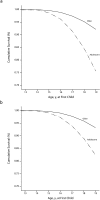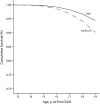Like father, like son: the intergenerational cycle of adolescent fatherhood
- PMID: 20075312
- PMCID: PMC2820067
- DOI: 10.2105/AJPH.2009.177600
Like father, like son: the intergenerational cycle of adolescent fatherhood
Abstract
Objectives: Strong evidence exists to support an intergenerational cycle of adolescent fatherhood, yet such a cycle has not been studied. We examined whether paternal adolescent fatherhood (i.e., father of study participant was age 19 years or younger when his first child was born) and other factors derived from the ecological systems theory predicted participant adolescent fatherhood.
Methods: Data included 1496 young males who were interviewed annually from the National Longitudinal Survey of Youth 1997. Cox regression survival analysis was used to determine the effect of paternal adolescent fatherhood on participant adolescent fatherhood.
Results: Sons of adolescent fathers were 1.8 times more likely to become adolescent fathers than were sons of older fathers, after other risk factors were accounted for. Additionally, factors from each ecological domain-individual (delinquency), family (maternal education), peer (early adolescent dating), and environment (race/ethnicity, physical risk environment)-were independent predictors of adolescent fatherhood.
Conclusions: These findings support the need for pregnancy prevention interventions specifically designed for young males who may be at high risk for continuing this cycle. Interventions that address multiple levels of risk will likely be most successful at reducing pregnancies among partners of young men.
Figures


Similar articles
-
Growing into teen fatherhood: a grounded theory study.Int Nurs Rev. 2018 Jun;65(2):244-253. doi: 10.1111/inr.12412. Epub 2017 Nov 21. Int Nurs Rev. 2018. PMID: 29159904
-
How many of the offspring born to teenage fathers are produced by repeated serious delinquents?Crim Behav Ment Health. 2002;12(1):83-98. doi: 10.1002/cbm.488. Crim Behav Ment Health. 2002. PMID: 12357259
-
The precursors of young fatherhood and its effect on delinquency of teenage males.J Adolesc Health. 1998 Jan;22(1):56-65. doi: 10.1016/S1054-139X(97)00211-5. J Adolesc Health. 1998. PMID: 9436068
-
Teen fathers: an introduction.School Nurse News. 2006 Jan;23(1):33-5. School Nurse News. 2006. PMID: 18386565 Review. No abstract available.
-
The antecedents and consequences of adolescent fatherhood: A systematic review.Soc Sci Med. 2019 Jul;232:106-119. doi: 10.1016/j.socscimed.2019.04.031. Epub 2019 Apr 22. Soc Sci Med. 2019. PMID: 31075751
Cited by
-
Pregnancy desire among a sample of young couples who are expecting a baby.Perspect Sex Reprod Health. 2012 Dec;44(4):244-51. doi: 10.1363/4424412. Epub 2012 Oct 17. Perspect Sex Reprod Health. 2012. PMID: 23231332 Free PMC article.
-
The impact of future expectations on adolescent sexual risk behavior.J Youth Adolesc. 2015 Jan;44(1):170-83. doi: 10.1007/s10964-013-0082-7. Epub 2013 Dec 20. J Youth Adolesc. 2015. PMID: 24357042 Free PMC article.
-
Interventions for improving the health and socioeconomic well-being of young parents in Africa: a systematic review protocol.BMJ Open. 2024 Aug 5;14(8):e083191. doi: 10.1136/bmjopen-2023-083191. BMJ Open. 2024. PMID: 39107023 Free PMC article.
-
Psychosocial factors associated with becoming a young father in Finland: a nationwide longitudinal study.BMC Public Health. 2012 Jul 27;12:560. doi: 10.1186/1471-2458-12-560. BMC Public Health. 2012. PMID: 22838840 Free PMC article.
-
Do children born to teenage parents have lower adult intelligence? A prospective birth cohort study.PLoS One. 2017 Mar 9;12(3):e0167395. doi: 10.1371/journal.pone.0167395. eCollection 2017. PLoS One. 2017. PMID: 28278227 Free PMC article.
References
-
- People: reproductive health : World Development Indicators 2006 Washington, DC: World Bank; 2006. Available at: http://devdata.worldbank.org/wdi2006/contents/home.htm. Accessed December 16, 2009
-
- Martin JA, Hamilton BE, Sutton PD, et al. Births: final data for 2006. Natl Vital Stat Rep 2009;57(7):1–102 - PubMed
-
- Coley R, Chase-Lansdale P. Adolescent pregnancy and parenthood: recent evidence and future directions. Am Psychol 1998;53(2):152–166 - PubMed
-
- Maynard R. Kids Having Kids: A Robin Hood Foundation Special Report on the Costs of Adolescent Childbearing New York, NY: Robin Hood Foundation; 1996
Publication types
MeSH terms
Grants and funding
LinkOut - more resources
Full Text Sources
Medical

